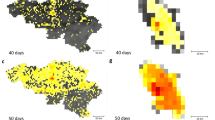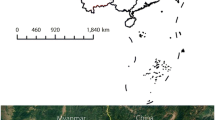Abstract
Malaria remains an endemic disease in many developing countries around the world. For several decades, various malaria control strategies have been developed and implemented in many countries. Many fields like medicine, biology, physics, mathematics, and computer sciences are used to set up these strategies. Mathematical models have proven to be very useful in understanding malaria progression and dynamics. Mainly, these models are based on differential equations and take into account the clinical and biological characteristics of patients and vectors. They made it possible to study the parts of the population which pass from a state of exposure to the disease to different possible states as a result. These mathematical models in general consider global estimates of the evolution of the epidemic based on unspecified percentages of the population. Individuals are considered fairly evenly. However, the health status of each individual as well as their own daily activities can have a particular influence on the epidemic evolution. The objective of this paper is to propose a model based on a daily evolution of the individual’s condition, which depends on their mobility and the characteristics of the territory they visit. Thus, mobility data of a single person moving from one area to another is used to calculate disease progression and predict outcomes. We implement our solution and demonstrate its effectiveness through empirical experiments. The results show how promising the model is in providing possible information on the failure of disease control in the Kédougou region.
Access this chapter
Tax calculation will be finalised at checkout
Purchases are for personal use only
Similar content being viewed by others
References
Armbrust, M., et al.: Spark SQL: relational data processing in spark. In: SIGMOD International Conference on Management of Data, pp. 1383–1394. ACM (2015)
Arthur, S.: Malaria incubation period (2017). http://malaria.emedtv.com/malaria/malaria-incubation-period.html. Accessed 29 Mar 2017
Barrett, C.L., Bisset, K.R., Eubank, S.G., Feng, X., Marathe, M.V.: Episimdemics: an efficient algorithm for simulating the spread of infectious disease over large realistic social networks. In: SC 2008: Proceedings of the 2008 ACM/IEEE Conference on Supercomputing, pp. 1–12 (2008)
Bisset, K.R., Chen, J., Feng, X., Kumar, V.A., Marathe, M.V.: Epifast: a fast algorithm for large scale realistic epidemic simulations on distributed memory systems. In: Proceedings of the 23rd International Conference on Supercomputing. p. 430–439. ICS 2009, Association for Computing Machinery, New York, NY, USA (2009). https://doi.org/10.1145/1542275.1542336
Bratman, M.: Intention, Plans, and Practical Reason. Harvard University Press, Cambridge, MA (1987)
Chen, Y..-D.., Chen, H.., King, C..-C..: Social network analysis for contact tracing. In: Infectious Disease Informatics and Biosurveillance. ISIS, vol. 27, pp. 339–358. Springer, Boston, MA (2011). https://doi.org/10.1007/978-1-4419-6892-0_15
Chitnis, N., Cushing, J., Hyman, J.: Bifurcation analysis of a mathematical model for malaria transmission. SIAM J. Appl. Math. 67(1), 24–45 (2006). https://doi.org/10.1137/050638941
Chitnis, N., Hyman, J.M., Cushing, J.M.: Determining important parameters in the spread of malaria through the sensitivity analysis of a mathematical model. Bull. Math. Biol. 70(5), 1272–1296 (2008). https://doi.org/10.1007/s11538-008-9299-0
Cook, V.J., et al.: Transmission network analysis in tuberculosis contact investigations. J. Infect. Dis. 196(10), 1517–1527 (2007). https://doi.org/10.1086/523109
Dharmawardena, P., et al.: Response of imported malaria patients to antimalarial medicines in Sri Lanka following malaria elimination. PLOS ONE 12(11), 1–14 (2017). https://doi.org/10.1371/journal.pone.0188613
Diekmann, O., Heesterbeek, J.: Mathematical Epidemiology of Infectious Diseases: Model Building, Analysis and Interpretation. Wiley Series in Mathematical and Computational Biology, Wiley (2000). https://books.google.sn/books?id=5VjSaAf35pMC
Dimitrov, N.B., Meyers, L.A.: Mathematical Approaches to Infectious Disease Prediction and Control, Chapter 1, pp. 1–25. INFORMS (2010). https://doi.org/10.1287/educ.1100.0075
For Disease Control, C., Prevention (2015). https://www.cdc.gov/malaria/about/disease.html. Accessed 29 May 2017
Filipe, J.A., Riley, E.M., Drakeley, C.J., Sutherland, C.J., Ghani, A.C.: Determination of the processes driving the acquisition of immunity to malaria using a mathematical transmission model. PLoS Comput. Biol. 3(12), 1–11 (2007)
Gharbi, M., et al.: Surveillance of travellers: an additional tool for tracking antimalarial drug resistance in endemic countries. PLOS ONE 8(10), 1–11 (2013). https://doi.org/10.1371/journal.pone.0077775
Gouvernement du Sénégal: National malaria control program (2017). http://www.pnlp.sn/. Accessed 25 Jan 2019
Greenwood, B., Marsh, K., Snow, R.: Why do some african children develop severe malaria? Parasitol. Today 7(10), 277–281 (1991)
Gu, W., Killeen, G.F., Mbogo, C.M., Regens, J.L., Githure, J.I., Beier, J.C.: An individual-based model of plasmodium falciparum malaria transmission on the coast of Kenya. Trans. Royal Soc. Trop. Med. Hyg. 97(1), 43–50 (2003). https://doi.org/10.1016/S0035-9203(03)90018-6
Gu, W., Mbogo, C.M., Githure, J.I., Regens, J.L., Killeen, G.F., Swalm, C.M., Yan, G., Beier, J.C.: Low recovery rates stabilize malaria endemicity in areas of low transmission in coastal kenya. Acta Tropica 86(1), 71–81 (2003). https://doi.org/10.1016/S0001-706X(03)00020-2, http://www.sciencedirect.com/science/article/pii/S0001706X03000202
He, S., Peng, Y., Sun, K.: Seir modeling of the COVID-19 and its dynamics. Nonlinear Dyn. 101(3), 1667–1680 (2020)
Jolly, A.M., Wylie, J.L.: Gonorrhoea and chlamydia core groups and sexual networks in manitoba. Sex. Trans. Infect. 78(suppl 1), i145–i151 (2002). https://sti.bmj.com/content/78/suppl_1/i145
Kermack, W.O., McKendrick, A.G.: Contributions to the mathematical theory of epidemics. III. Further studies of the problem of endemicity. R. Soc. of Lond. Ser. A 141(843), 94–122 (1933)
Kermack, W.O., McKendrick, A.G.: A contribution to the mathematical theory of epidemics. R. Soc. Lond. Ser. A 115(772), 700–721 (1927)
Khiri, L.B., Gueye, I., Naacke, H., Sarr, I., Gançarski, S.: A malaria control model using mobility data: an early explanation of kedougou case in senegal. In: Rango, F.D., Ören, T.I., Obaidat, M.S. (eds.) Proceedings of the 10th International Conference on Simulation and Modeling Methodologies, Technologies and Applications, SIMULTECH 2020, Lieusaint, Paris, France, 8–10 July 2020, pp. 35–46. ScitePress (2020). https://doi.org/10.5220/0009591800350046
Klovdahl, A.S.: Social networks and the spread of infectious diseases: the aids example. Soc. Sci. Med. 21(11), 1203–1216 (1985). https://doi.org/10.1016/0277-9536(85)90269-2, http://www.sciencedirect.com/science/article/pii/0277953685902692
Koella, J.C.: On the use of mathematical models of malaria transmission. Acta Trop. 49(1), 1–25 (1991)
Lechthaler, F., et al.: Trends in reported malaria cases and the effects of malaria control in the democratic republic of the congo. PLOS ONE 14(7), 1–20 (2019). https://doi.org/10.1371/journal.pone.0219853
Leskovec, J., Rajaraman, A., Ullman, J.D.: Mining of Massive Datasets, 2nd Ed. Cambridge University Press (2014). http://www.mmds.org/
Lin, Q., Zhao, S., Gao, D., Lou, Y., Yang, S., Musa, S.S., Wang, M.H., Cai, Y., Wang, W., Yang, L., He, D.: A conceptual model for the coronavirus disease 2019 (COVID-19) outbreak in Wuhan, china with individual reaction and Governmental action. Int. J. Infect. Dis. 93, 211–216 (2020)
MacQueen, K.M.: The epidemiology of HIV transmission: trends, structure and dynamics. Ann. Rev. Anthropol. 23, 509–526 (1994)
Mandal, S., Sarkar, R.R., Sinha, S.: Mathematical models of malaria - a review. Malaria J. 10(1), 1–19 (2011). https://doi.org/10.1186/1475-2875-10-202
National Agency of Statistics and Demography (ANSD): Projection de la population de la région de kedougou - 2013–2025 (2013). http://www.ansd.sn/ressources/publications/indicateurs/Projections-demographiques-2013-2025+.htm. Accessed 02 May 2019
Odell, P.R.: Book Review: Bailey, n.t.j. 1975: The Mathematical Theory of Infectious Diseases and its Application. London: Griffin: Thom, r. 1975: Structural Stability and Morphogenesis. Reading, Massachusetts: Benjamin. Progress in Human Geography, 7(3), 442–444 (1983)
Oldham, P.D.: The mathematical theory of epidemics. J. R. Stat. Soc. Ser. C 8(1), 60–61 (1959). https://ideas.repec.org/a/bla/jorssc/v8y1959i1p60-61.htm
Packer, S., Green, C., Brooks-Pollock, E., Chaintarli, K., Harrison, S., Beck, C.: Social network analysis and whole genome sequencing in a cohort study to investigate tb transmission in an educational setting. BMC Infect. Dis. 19 (2019)
Parham, P.: The Immune System. No. in The Immune System, Garland Science, p. 246 (2009). https://books.google.sn/books?id=mVRRAAAACAAJ
Parham, P., Ferguson, N.: Space and contact networks: capturing the locality of disease transmission. J. R. Soc. Interface 3, 483–493 (2006). https://doi.org/10.1098/rsif.2005.0105
PNLP: Bulletin de surveillance sentinelle du paludisme (2017). http://www.pnlp.sn/bulletin-de-surveillance-sentinelle-du-paludisme/. Accessed 30 Aug 2019
Ross, R.: The Prevention of Malaria. John Murray, Albemarle Street (1911). https://books.google.fr/books?id=GDUzAQAAMAAJ
Ruktanonchai, N.W., et al.: Identifying malaria transmission foci for elimination using human mobility data. PLOS Comput. Biol. 12(4), 1–19 (2016). https://doi.org/10.1371/journal.pcbi.1004846
Sattenspiel, L., Dietz, K.: A structured epidemic model incorporating geographic mobility among regions. Math. Biosci. 128(1), 71–91 (1995). https://doi.org/10.1016/0025-5564(94)00068-B
Stattner, E., Vidot, N.: Social network analysis in epidemiology: Current trends and perspectives. In: International Conference on Research Challenges in Information Science, pp. 1–11 (2011)
Thiam, S., et al.: Major reduction in anti-malarial drug consumption in Senegal after nation-wide introduction of malaria rapid diagnostic tests. PLOS ONE 6(4), 1–7 (2011)
Watts, D.J., Muhamad, R., Medina, D.C., Dodds, P.S.: Multiscale, resurgent epidemics in a hierarchical metapopulation model. Proc. Natl. Acad. Sci. 102(32), 11157–11162 (2005). https://doi.org/10.1073/pnas.0501226102
WHO Inc.: OMS | 10 faits sur le paludisme (2016). http://www.who.int/features/factfiles/malaria/fr/ Accessed 15 May 2017
Author information
Authors and Affiliations
Corresponding author
Editor information
Editors and Affiliations
Rights and permissions
Copyright information
© 2022 The Author(s), under exclusive license to Springer Nature Switzerland AG
About this paper
Cite this paper
Gueye, I., Naacke, H., Sarr, I., Khiri, L.B., Gancarski, S. (2022). Malaria Control: Epidemic Progression Calculation Based on Individual Mobility Data. In: Obaidat, M.S., Oren, T., Rango, F.D. (eds) Simulation and Modeling Methodologies, Technologies and Applications. SIMULTECH 2020. Lecture Notes in Networks and Systems, vol 306. Springer, Cham. https://doi.org/10.1007/978-3-030-84811-8_8
Download citation
DOI: https://doi.org/10.1007/978-3-030-84811-8_8
Published:
Publisher Name: Springer, Cham
Print ISBN: 978-3-030-84810-1
Online ISBN: 978-3-030-84811-8
eBook Packages: Intelligent Technologies and RoboticsIntelligent Technologies and Robotics (R0)




